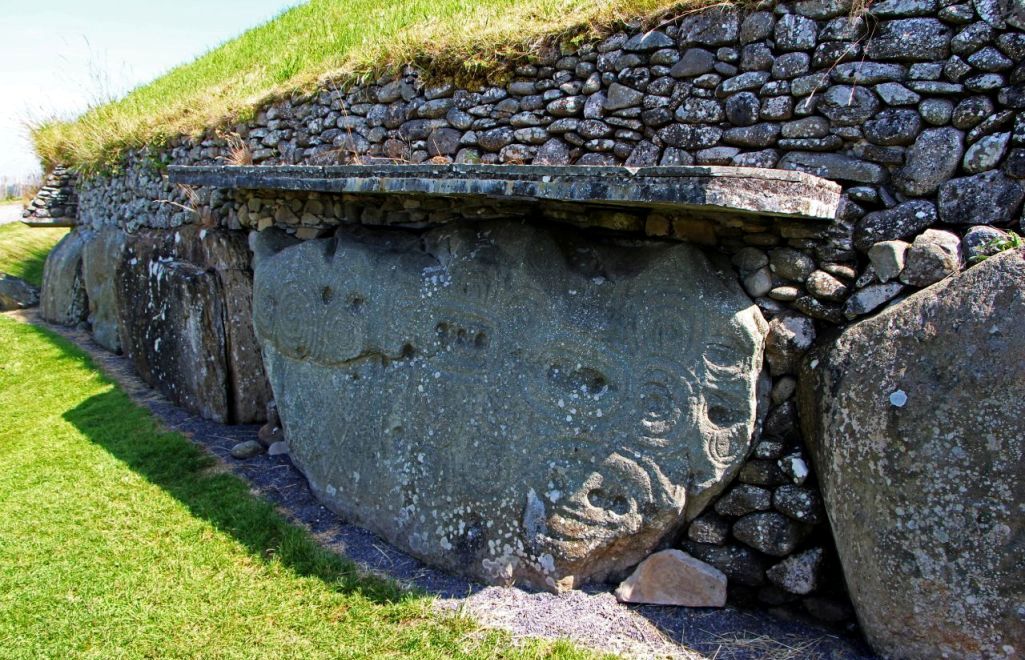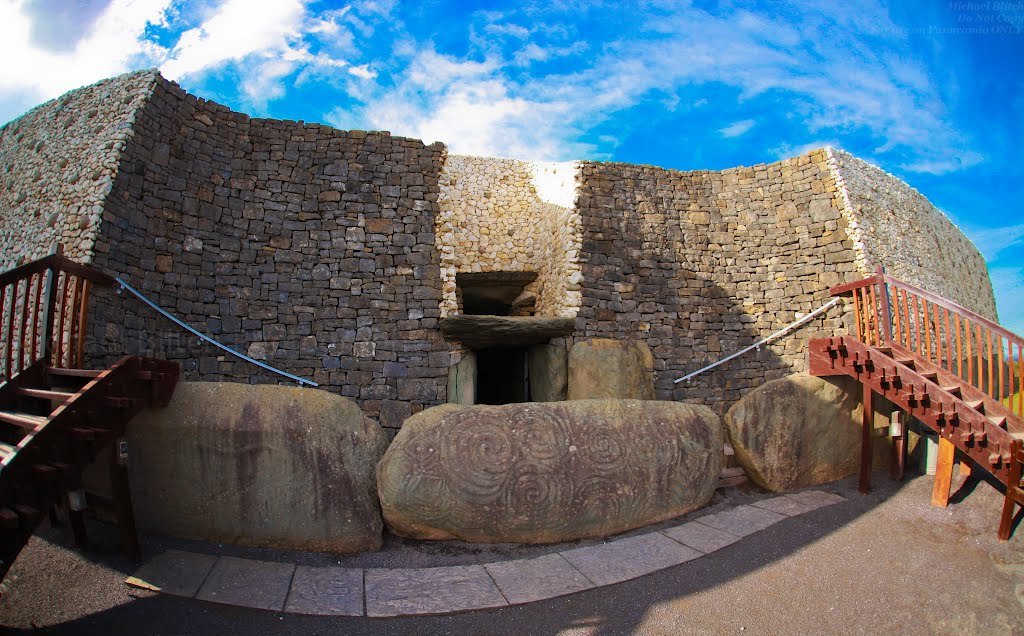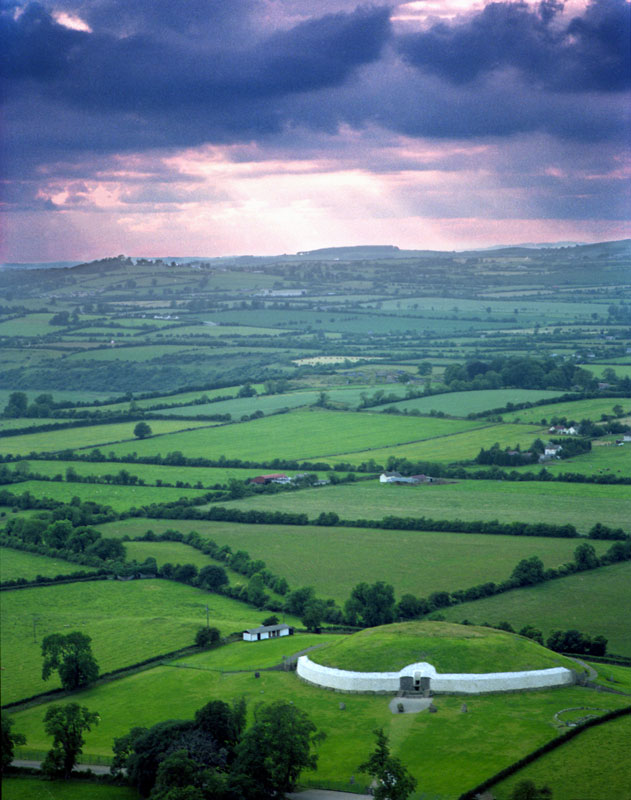
Newgrange is a prehistoric monument in County Meath, Ireland, located 8 kilometres (5.0 mi) west of Drogheda on the north side of the River Boyne. It is an exceptionally grand passage tomb built during the Neolithic period, around 3200 BC, making it older than Stonehenge and the Egyptian pyramids.
The site consists of a large circular mound with an inner stone passageway and chambers. Human bones and possible grave goods or votive offerings were found in these chambers. The mound has a retaining wall at the front, made mostly of white quartz cobblestones, and it is ringed by engraved kerbstones. Many of the larger stones of Newgrange are covered in megalithic art. The mound is also ringed by a stone circle. Some of the material that makes up the monument came from as far away as the Mournes and Wicklow Mountains. There is no agreement about what the site was used for, but it is believed that it had religious significance. Its entrance is aligned with the rising sun on the winter solstice, when sunlight shines through a 'roofbox' and floods the inner chamber. Several other passage tombs in Ireland are aligned with solstices and equinoxes, and Cairn G at Carrowkeel has a similar 'roofbox'. Newgrange also shares many similarities with other Neolithic constructions in Western Europe, especially Gavrinis in Brittany, which has both a similar preserved facing and large carved stones, in that case lining the passage within. Maeshowe in Orkney, Scotland, with a large high corbelled chamber, and Bryn Celli Ddu in Wales have also been compared to Newgrange.

It is the most famous monument within the Neolithic Brú na Bóinne complex, alongside the similar passage tomb mounds of Knowth and Dowth, and as such is a part of the Brú na Bóinne UNESCO World Heritage Site. Newgrange consists of approximately 200,000 tonnes of rock and other materials. It is 85 metres (279 ft) wide at its widest point.
After its initial use, Newgrange was sealed for several millennia. It continued to feature in Irish mythology and folklore, in which it is said to be a dwelling of the deities, particularly The Dagda and his son Aengus. Antiquarians first began its study in the seventeenth century, and archaeological excavations took place at the site in the years that followed. Archaeologist Michael J. O'Kelly led the most extensive of these and also reconstructed the frontage of the site in the 1970s, a reconstruction that is controversial and disputed. Newgrange is a popular tourist site and, according to the archaeologist Colin Renfrew, is "unhesitatingly regarded by the prehistorian as the great national monument of Ireland" and as one of the most important megalithic structures in Europe.

Access to Newgrange is by guided tour only. Tours begin at the Brú na Bóinne Visitor Centre from which visitors are taken to the site in groups. Current-day visitors to Newgrange are treated to a guided tour and an re-enactment of the Winter Solstice experience through the use of high-powered electric lights situated within the tomb. The finale of a Newgrange tour results in every visitor standing inside the tomb where the tour guide then turns off the lights, and then turns on ones simulating the sunlight that would appear on the winter solstice.
To experience the phenomenon on the morning of the Winter Solstice from inside Newgrange, visitors to Bru Na Bóinne Visitor Centre must enter an annual lottery at the centre. Of the thousands who enter, twenty are chosen each year. The winner is permitted to bring a single guest. The winners are split into groups of ten and taken in on the five days around the solstice in December when sunlight can enter the chamber, weather permitting.

The Newgrange monument primarily consists of a large mound, built of alternating layers of earth and stones, with grass growing on top and a reconstructed facade of flattish white quartz stones studded at intervals with large rounded cobbles covering part of the circumference. The mound is 76 metres (249 ft) across and 12 metres (39 ft) high, and covers 4,500 square metres (1.1 acres) of ground. Within the mound is a chambered passage, which may be accessed by an entrance on the southeastern side of the monument. The passage stretches for 19 metres (60 ft), or about a third of the way into the centre of the structure. At the end of the passage are three small chambers off a larger central chamber with a high corbelled vault roof. Each of the smaller chambers has a large flat "basin stone" where the bones of the dead may have been deposited during prehistoric times. Whether it was a burial site remains unclear. The walls of this passage are made up of large stone slabs, twenty-two of which are on the western side and twenty-one on the eastern side. They average 1½ metres in height; several are decorated with carvings (as well as graffiti from the period after the rediscovery). The ceiling shows no evidence of smoke.
The entrance passage to Newgrange, and the entrance stone
Situated around the perimeter of the mound is a circle of standing stones. Twelve standing-stones survive out of a possible original thirty-five or thereabouts. Most archaeologists suggest that they were added later, during the Bronze Age, centuries after the original monument had been abandoned as a ritual centre.

The Neolithic people who built the monument were native agriculturalists, growing crops and raising animals such as cattle in the area where their settlements were located.
During the medieval period, Newgrange and the wider Brú na Bóinne Neolithic complex gained various attributes in local folklore, which was often connected to figures from wider Irish mythology. The monuments of the Brú were thought of by some as being the abode of the supernatural Tuatha De Danann, whilst others considered them to be the burial mounds of the ancient kings of Tara. Amongst those who believed the folkloric tales relating the Brú to the Tuatha De Danann, it was commonly thought that they were the abode of the most powerful of the Tuatha, particularly The Dagda, his wife Boann, and his son, Oengus. According to the eleventh-century Book of Lecan, the Dagda had built the Brú for use by his family, whilst the twelfth-century Book of Leinster describes how Oengus tricked his father into giving him the Brú for all eternity. Another text, The Pursuit of Diarmaid and Grainne also implies that Oengus owned the Brú, when he declared how he took his friend Diarmaid to it.
Sometime after 1142 the structure became part of outlying farmland owned by the Cistercian Abbey of Mellifont. These farms were referred to as 'granges'. Newgrange is not mentioned in any of the early charters of the twelfth and thirteenth centuries, but an Inspeximus granted by Edward III in 1348 includes a Nova Grangia among the demesne lands of the abbey.
On 23 July 1539, following the Dissolution of the Monasteries by Henry VIII, Mellifont Abbey and its demesnes became the fortified mansion of an English soldier of fortune, Edward Moore, ancestor of the Earls of Drogheda.
On 14 August 1699, Alice Moore, Countess Dowager of Drogheda, leased the demesne of Newgrange to a Williamite settler, Charles Campbell, for 99 years




